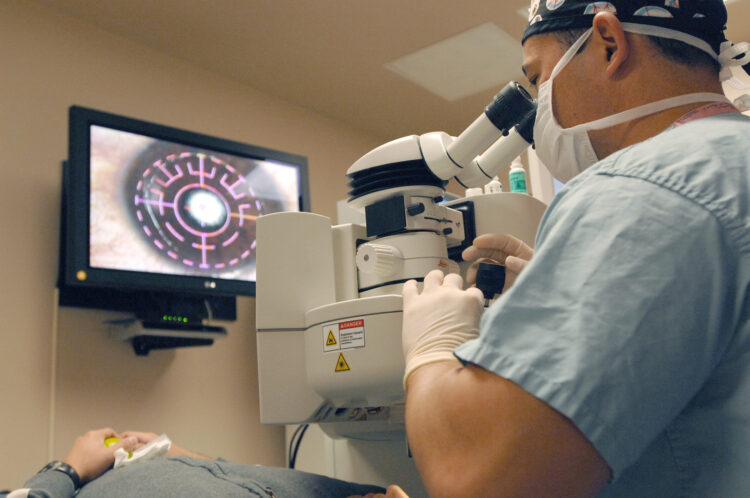Corneal grafting, also known as a cornea transplant, involves a surgical procedure that aims to replace a damaged or diseased cornea with a healthy one obtained from a donor. The cornea is the clear, dome-shaped surface that covers the front of the eye and is responsible for focusing light onto the retina.
When the cornea is damaged due to injury, infection, or disease, vision can become blurred or distorted. In severe cases, corneal transplantation may be necessary to restore vision.
Cornea transplant surgery is a delicate and complex procedure that requires specialized skills and expertise. The procedure involves removing the damaged or diseased cornea and replacing it with a donor cornea that has been carefully matched to the recipient’s eye.
While the surgery is not without risks, it can have a significant impact on the quality of life for those suffering from corneal diseases or injuries. In this article, we will explore the process and benefits of cornea transplant surgery in more detail.
The Process of Cornea Transplant Surgery
Preoperative Evaluation

Medical History and Eye Exam
Before the surgery, the patient will undergo a thorough medical history and eye exam to evaluate their suitability for the procedure. The doctor will review the patient’s medical history, including any medications or allergies, and perform a comprehensive eye exam to assess the condition of the cornea and overall eye health.
Donor Cornea Selection and Testing
The selection of a donor cornea is a critical aspect of the surgery. The donor cornea must match the recipient’s eye size, shape, and tissue type to minimize the risk of rejection. The cornea also undergoes various tests to ensure that it is healthy and free from infectious diseases.
Patient Education and Informed Consent
The patient will receive detailed information about the surgery, including the risks, benefits, and expected outcomes. The doctor will explain the procedure, anesthesia options, and postoperative care instructions to the patient. The patient will then provide informed consent before the surgery can proceed.
Surgical Procedure

Anesthesia and Incision
The surgery is typically performed under local anesthesia with sedation, which numbs the eye and allows the patient to remain awake but relaxed. The doctor then makes a small incision in the eye to access the cornea.
Removal of Damaged Cornea
The doctor carefully removes the damaged cornea using a surgical tool called a trephine. This instrument cuts and removes a circular section of the cornea, leaving a gap in the eye.
Donor Cornea Implantation
The donor cornea is then carefully placed into the gap and secured in place with tiny sutures. The doctor uses a special microscope to ensure precise placement and alignment of the new cornea.
Suturing and Bandaging
After the cornea is in place, the doctor sutures the incision site closed and applies a protective bandage to the eye. The bandage helps protect the eye and keeps the new cornea in place as it heals. The patient may need to wear an eye patch or shield for a few days after the surgery to protect the eye from injury.
Postoperative Care and Follow-Up

Medications and Eye Drops
After the surgery, the patient will need to use prescription medications and eye drops to prevent infection and reduce inflammation. The doctor may also prescribe pain medication to manage discomfort during the initial recovery period.
Eye Protection and Rest
The patient will need to protect their eye from injury and avoid strenuous activities that could put stress on the eye during the initial recovery period. The doctor may recommend limiting screen time and getting plenty of rest to help the eye heal.
Monitoring for Complications
The doctor will monitor the patient closely for signs of complications, such as infection, rejection, or increased intraocular pressure. The patient will need to report any unusual symptoms, such as pain, redness, or vision changes, to the doctor immediately.
Follow-Up Visits and Rehabilitation
The patient will need to attend follow-up visits with the doctor to monitor the healing process and check the new cornea’s function. The doctor may also recommend vision rehabilitation, such as corrective lenses or vision therapy, to help the patient regain optimal vision.
Benefits of Cornea Transplant Surgery

Restored Clarity and Sharpness of Vision
Cornea transplant surgery can restore clarity and sharpness of vision that was lost due to corneal damage or disease. Patients may experience improved visual acuity, better contrast sensitivity, and enhanced color perception, which can greatly improve their quality of life.
Reduction of Eye Pain and Discomfort
Corneal damage or disease can cause severe eye pain, discomfort, and sensitivity to light. Cornea transplant surgery can alleviate these symptoms and improve overall eye comfort and function.
Increased Independence and Mobility
Improved vision after cornea transplant surgery can increase a patient’s independence and mobility. Patients may be able to resume daily activities, such as driving, reading, and working, that were previously difficult or impossible due to poor vision. This can greatly enhance their overall quality of life and well-being.
Risks and Considerations of Cornea Transplant Surgery

Like any surgery, cornea transplant surgery comes with potential risks and considerations. Risks associated with the surgery include infection, bleeding, and rejection of the donor cornea. Additionally, there may be complications related to the use of anesthesia, such as an allergic reaction or breathing difficulties.
Before undergoing cornea transplant surgery, patients should discuss their medical history, including any underlying health conditions or medications they are taking, with their doctor. Patients should also be aware that the recovery process can be lengthy, and they may need to take time off work or make other accommodations during this time.
While there are risks and considerations associated with cornea transplant surgery, it can be a highly effective treatment option for individuals with corneal damage or disease, offering improved vision and quality of life.
However, for individuals who are not suitable candidates for cornea transplant surgery, or who require additional vision correction after the procedure, alternative options such as over-muscle implants may be worth exploring. It’s important to consult with a qualified medical professional to determine the best treatment plan for each case.
Conclusion
Cornea transplant surgery is a highly effective treatment option for individuals with corneal damage or disease, offering improved vision and quality of life. The process involves a preoperative evaluation, surgical procedure, and postoperative care and follow-up.
While there are risks and considerations associated with the surgery, with proper medical evaluation and care, many individuals can benefit greatly from the procedure. Individuals need to discuss their options with a qualified medical professional to determine if cornea transplant surgery is the right treatment option for them.
Overall, this surgery has the potential to significantly improve vision and enhance the overall quality of life for those suffering from corneal damage or disease.
 Hi Boox Popular Magazine 2024
Hi Boox Popular Magazine 2024



